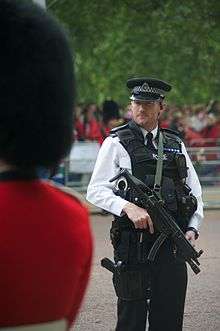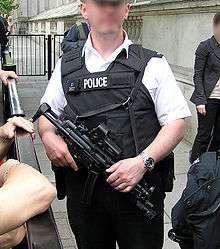Authorised firearms officer
An authorised firearms officer (AFO) is a British police officer who has received training, and is authorised, to carry and use firearms. The designation is significant because in the United Kingdom most police officers do not routinely carry firearms, although they can be equipped with tasers. The only forces where officers are routinely armed are the Police Service of Northern Ireland, the Ministry of Defence Police, the Civil Nuclear Constabulary, Belfast Harbour Police and the Belfast International Airport Constabulary.

.jpg)

.jpg)
In 2014/15, there were 5,647 authorised firearms officers and 14,666 police operations throughout England and Wales in which the deployment of firearms was authorised.[1] Following the November 2015 Paris attacks it was decided to significantly increase the numbers of armed officers, particularly in London.[2]
AFOs are often deployed in armed response vehicles (ARV) or on static security duties.
Training
All police forces in the United Kingdom have an AFO selection process,[3] varying slightly between each force. As with many police specialities, all authorised firearms officers have volunteered for the role. Candidates are required to gain approval from their superiors before embarking on a series of interviews, psychological and physical fitness tests, medical examinations and assessment days, before permission to commence firearms training is given. There is no guarantee of success; candidates can be returned to their previous role at any point in training if they do not meet the required standard.
Once authorised, AFOs must pass regular refresher training and retests in order to maintain their authorisation. Failure to meet the required standards can result in the officer having their firearms authorisation revoked. Health or fitness problems can also result in temporary or permanent suspension from firearms duties.
Use of authorised firearms officers
AFOs are used by some specialist units of police forces throughout the United Kingdom, who by nature of their role have a requirement to deploy armed police officers. Such units include the Diplomatic Protection Group of the Metropolitan Police Service, armed response vehicles in various police forces throughout the UK, in airport policing, and officers of the Ministry of Defence Police[4] and the Civil Nuclear Constabulary.
It is also known that the National Crime Agency makes use of AFOs, notably having an Armed Operations Unit. These officers rarely engage in anti-terror operations, but primarily focus actions on violent, organised crime – including the trafficking of firearms.
Legal status of the use of firearms
The use of firearms by the police is covered by statute (such as the Police and Criminal Evidence Act 1984 and Human Rights Act 1998), policy (such as the Home Office Code of Practice on Police use of Firearms and Less Lethal Weapons and the ACPO Manual of Guidance on Police Use of Firearms) and common law.
AFOs may only carry firearms when authorised by an "appropriate authorising officer".[5] The appropriate authorising officer must be of the rank of inspector or higher.[6] When working at airports, nuclear sites, on protection duties and deployed in armed response vehicles in certain areas, 'standing authority' is granted to carry personal sidearms.[7] All members of the Police Service of Northern Ireland have authority to carry a personal issue handgun as a matter of routine, both on duty and off.[8]
United Kingdom law allows the use of "reasonable force" in order to make an arrest or prevent a crime[9][10] or to defend oneself.[11] However, if the force used is fatal, then the European Convention of Human Rights only allows "the use of force which is no more than absolutely necessary".[12] Firearms officers may therefore only discharge their weapons "to stop an imminent threat to life".[13]
ACPO policy states that "use" of a firearm includes both pointing it at a person and discharging it (whether accidentally, negligently or on purpose).[14] As with all use of force in England and Wales, the onus is on the individual officer to justify their actions in court.[15]
Specialist firearms officers
Specialist firearms officers (SFOs) are AFOs trained in skills such as dynamic intervention and dynamic entry and may intervene in more serious firearms incidents such as sieges or high-risk pre-planned operations. SFOs receive a higher level of training than AFOs, in areas such as method of entry into various structures and in the use of specialist weapons and equipment.
SFOs must already have served as an Armed Response Vehicle officer before undertaking an 18-week training course, on top of their initial AFO qualification.
Since 2014, all SFOs serving with the Metropolitan Police Service have undergone additional training in order to qualify as Counter Terrorist Specialist Firearms Officers (CTSFOs) due to an increase in terrorist incidents, such as the 2015 Paris bombings and armed-offender rampages (such as in Belgium in 2016), where a higher level of armed response is required from police to contain active threats. SFOs in other forces, including West Midlands Police, Thames Valley Police and Greater Manchester Police have also been up-skilled to CTSFO standard, creating the Counter Terrorism Network.
Firearms currently used by AFOs
Different police forces in the United Kingdom use different firearms. For forces in England and Wales, guidance is provided from ACPO and the Home Office.[16] Decisions on which weapons will be employed by an individual police force largely rest with the chief constable.
Metropolitan Police
Within the London's Metropolitan Police, there are a number of Operational Command Units (OCUs) that employ AFOs.
- The Belmarsh Firearms Team protects trials at Woolwich Crown Court
- The Territorial Support Group has a small pool of AFOs for assisting other armed officers in the event of a major terror attack.[17]
- The Specialist Crime Directorate arms certain surveillance officers.
- Most detectives in the Flying Squad are armed.
- Special Branch deploys armed officers in its surveillance units, and in A Squad, which protects the Prime Minister and other dignitaries.
- Royalty and Diplomatic Protection, which protects members of the Royal Family and high level government officials, and guards royal property.
- Special Escort Group, which escorts and protects high-risk convoys and VIPs such as the Prime Minister and the Queen. SEG officers are armed with Glock 17 pistols and Tasers.
- Parliamentary and Diplomatic Protection, which guards embassies and government buildings. It also provides the armed guards at Parliament to supplement the Palace of Westminster Division, which is unarmed.
- Aviation Security, which protects Heathrow and London City airports.
- Specialist Firearms Command (SCO19), which provides armed support to the rest of the service, crewing Armed Response Vehicles responding to spontaneous and pre-planned firearms operations.
Numbers of AFOs by police force
The numbers of firearms officers ranges from 31 in Warwickshire to 2,394 in the Metropolitan Police, although outside London there are only three forces with more than 200 firearms officers, those being Greater Manchester, Thames Valley and West Midlands.[18]
| Police force | Number |
|---|---|
| Avon & Somerset | 106 |
| Bedfordshire | 63 |
| Cambridgeshire | 59 |
| Cheshire | 50 |
| City of London | 80 |
| Cleveland | 49 |
| Cumbria | 68 |
| Derbyshire | 56 |
| Devon & Cornwall | 154 |
| Dorset | 59 |
| Durham | 52 |
| Dyfed-Powys | 62 |
| Essex | 175 |
| Gloucestershire | 71 |
| Greater Manchester | 257 |
| Gwent | 42 |
| Hampshire | 95 |
| Hertfordshire | 62 |
| Humberside | 79 |
| Kent | 99 |
| Lancashire | 79 |
| Leicestershire | 63 |
| Lincolnshire | 47 |
| Merseyside | 109 |
| Metropolitan | 2,394 |
| Norfolk | 155 |
| North Wales | 49 |
| North Yorkshire | 68 |
| Northamptonshire | 56 |
| Northumbria | 146 |
| Nottinghamshire | 62 |
| South Wales | 95 |
| South Yorkshire | 98 |
| Staffordshire | 80 |
| Suffolk | 54 |
| Surrey | 60 |
| Sussex | 139 |
| Thames Valley | 204 |
| Warwickshire | 31 |
| West Mercia | 106 |
| West Midlands | 231 |
| West Yorkshire | 165 |
| Wiltshire | 48 |
See also
- Firearms policy in the United Kingdom
- Garda Regional Support Units, Irish version of AFOs
References
- "Police use of firearms statistics, England and Wales: April 2014 to March 2015". Home Office. Retrieved 2016-06-21.
- White, Mark (13 January 2016). "Met Police To Double Armed Officers On Patrol". Sky News. Retrieved 13 January 2016.
- Waldren, Michael J. (2007). Armed Police, The Police Use of Firearms since 1945. England: Sutton. p. 224. ISBN 0-7509-4637-7.
- http://www.mod.uk/DefenceInternet/AboutDefence/WhatWeDo/SecurityandIntelligence/MDPGA/MinistryOfDefencePolice.htm
- ACPO (2003), Manual of Guidance on Police Use of Firearms, 3.2.1 Archived 2008-04-13 at the Wayback Machine
- ACPO (2003), Manual of Guidance on Police Use of Firearms, 3.6.6 Archived 2008-04-13 at the Wayback Machine
- ACPO (2003), Manual of Guidance on Police Use of Firearms, 3.8 Archived 2008-04-13 at the Wayback Machine
- ACPO (2003), Manual of Guidance on Police Use of Firearms, 3.8.5 Archived 2008-04-13 at the Wayback Machine
- Police and Criminal Evidence Act 1984, Section 117 or Police and Criminal Evidence (Northern Ireland) Order 1989, Article 88
- Criminal Law Act 1967, Section 3 or Criminal Law Act (Northern Ireland) 1967, Section 3
- Common Law, as cited in ACPO (2003), Manual of Guidance on Police Use of Firearms, 2.3.4 Archived 2008-04-13 at the Wayback Machine
- ACPO (2003), Manual of Guidance on Police Use of Firearms, 2.3.7 Archived 2008-04-13 at the Wayback Machine
- ACPO (2003), Manual of Guidance on Police Use of Firearms, 5.6.1 Archived 2008-04-13 at the Wayback Machine
- ACPO (2003), Manual of Guidance on Police Use of Firearms 3.2.4 Archived 2008-04-13 at the Wayback Machine
- ACPO (2003), Manual of Guidance on Police Use of Firearms Chapter 3.3.1 Archived 2008-04-13 at the Wayback Machine
- "Police Arms and Weaponry".
All the forces in the UK and Wales are also issued with the 'Firearms Guidance to Police' manual, a lengthy document detailing the legal regulation of firearms in the UK and covers the vast range of domestic legislation and international guidance on firearms use. Codes of practice are also issued by the Home Office providing comprehensive guidance on the policy and use of firearms and less lethal weapons by police.
- Admin, D. P. F. (2016-06-13). "Met to train riot police as back-up gun squad in case of terror attack". Defence Police Federation. Retrieved 2020-06-17.
- Gov.uk (27 July 2017). Police use of firearms statistics, England and Wales: April 2016 to March 2017: data tables. Retrieved 1 August 2017.